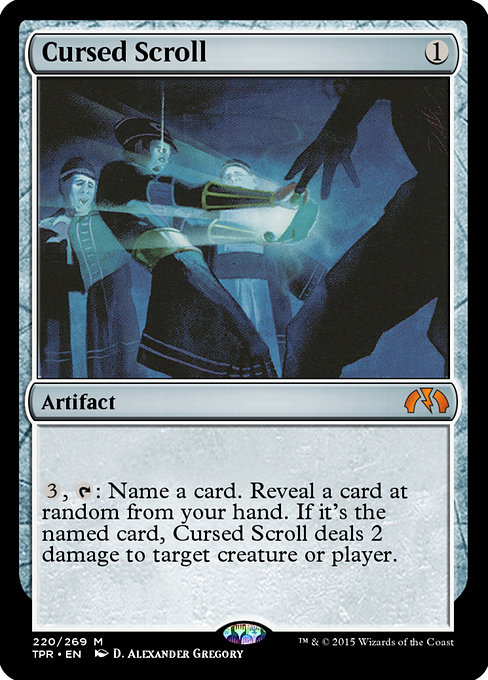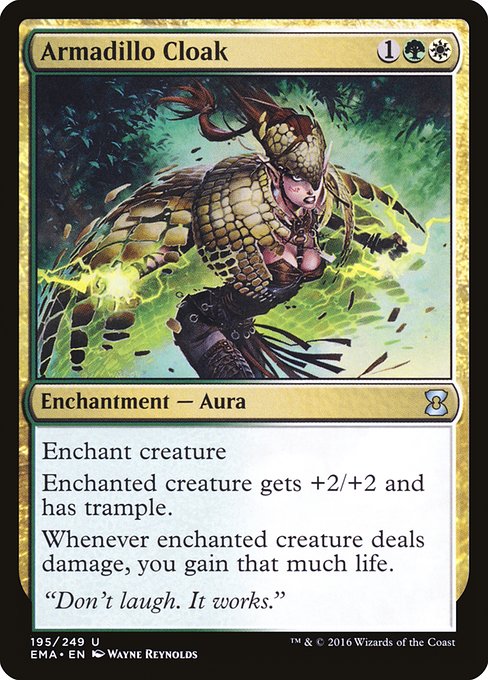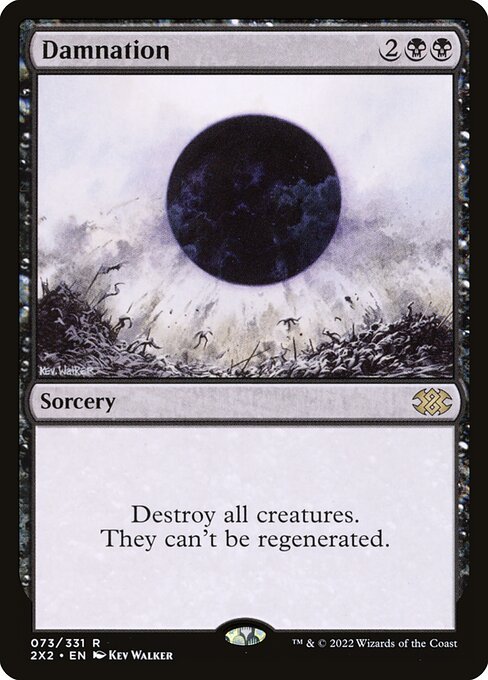Cover image: Foil by Donato Giancola
Back when I had aspirations of being a tournament player, back when the fever was on me and even the more tedious parts of Magic: The Gathering felt new and exciting—back before I ran the numbers and realized that, once you’d calculated the number of hours I spent waiting for rounds to be posted and driving to tournaments, I was losing more money than I could have hoped to make—I got some advice. Play the exact same version of every card, including lands, so as not to give information away to your opponent.
If they Thoughtseize you, and they see three different Mountains, then Thoughtseize on a later turn and see a fourth, a canny opponent will know that you had a dead draw in there and maneuver accordingly. If you play nothing but the same printing of all your Mountains, no only do you ensure your opponent is in the dark about what you draw and when you draw it, you can also get, as players in 1998 did, the psychological benefit of making them think they had awful luck picking a random card with Cursed Scroll. They never have to know that the three cards in your hand are all the same Mountain.

That was an easier proposition back then: when choosing a non land card for your deck, you had limited options, confined to set version, set foil, and promo (if any—your choice of textless or Judge or FNM). Foils carried a hefty premium, as they were vanishingly rare, and foil players needed foil playsets. Pre-1999, this was moot, as all printed cards were nonfoil, and only differed in edition. Older cards carried the premium; a Sixth Edition Wrath of God was worth slightly less than one from Revised, with black-bordered original printings holding the same cache that foils came to hold.
With Urza’s Legacy and the advent of foils, we entered a new era. Originally, foils replaced a card of the same rarity within the pack and dropped at a rate of one foil per sixty-seven cards—meaning you could expect to open a foil of any rarity in approximately every five packs. This was later adjusted to one foil in every forty-five cards, or every three packs. With Time Spiral back in 2006, the foil policy changed so that foils universally replaced a random common, meaning you could open a pack with four uncommons (one foil) or two rares (or, in Time Spiral’s case, even more, since you were guaranteed a time shifted card).
Modern Masters then introduced the “premium set” bonus of one foil of any rarity in each pack. This had the benefit of slightly increasing the available supply of foils in the market, and thus decreased prices a touch on less-tournament-desirable cards, while increasing the perceived value of the set. That’s a neat paradox that Wizards would come to rely upon in the future—they had set the expectation that foils were rare and desirable, and then increased the rate at which foils appeared, counting on the lingering cache of foil cards.

Back in the prehistoric epoch of the millennium and before the e-commerce boom, card shops could price foils at basically whatever they wanted; I remember a local comic shop charging a base rate of $1 for foil commons, $5 for foil uncommons, and $10 for foil rares. That was the base rate—tournament playable cards were astronomical, with an Armadillo Cloak back in 2003 going for $17, or $26.82 in today’s dollars. Back in that era, I recall trading a Flooded Strand for a foil Visara the Dreadful and believing I came out ahead on that deal (in all fairness, this has looped back around to being more or less equivalent. I’d rather have a Khans Strand and a foil Visara, personally).
That’s not to say foils are inherently preferable. Foils are difficult to keep pristine, even if they come out of the pack mint. Down here in the American South, the humidity warps them almost instantly, and they’re easier to scratch or cloud than nonfoil cards. Printing errors—the dark foils of Commander Legends, the curling foils that surfaced in the Warhammer 40,000 decks—and player preference for certain foil types over others (the From the Vault series foils, despite their rarity, don’t hit the heights of comparable set foils—the market doesn’t love them), combined with the fickleness of foils, means that the modern era of standard foils aren’t much more expensive than their nonfoil counterparts.
The introduction of extended art foils, showcase foils, special foils, and time-limited Secret Lairs means you can pick up a pack foil of a Lord Xander the Collector for the same price as the nonfoil—even the showcase version, with exclusive art, is only a buck or two more expensive. The premium version, the rarest, is the gilded foil—the gilded foil treatment is, in my estimation, gaudily gorgeous, and only available in set (at a 1% drop rate for any rare or mythic gilded foil) or Collector’s Boosters, and is priced accordingly. Even then, for a card with a unique printing only available through busting packs, it’s less than fifty bucks—pricy for cardboard, but not bad for a collector’s item.

Every player has their own personal ranking of preferred card frames and aesthetics—personally, I avoid extended art cards whenever possible while prioritizing, as a nostalgivore, retro border cards. The Secret Lair drop series has opened up Magic’s aesthetic boundaries beyond anything we could have imagined ten years ago, when the most outré tournament-legal card was textless Player Rewards Cryptic Command. Now, we can cast Junji Ito Thoughtseizes, MSCHF Blood Moons, D&D module lands, and borderless Liliana of the Veil.
I play Richard Kane Ferguson Grim Flayers in Pioneer, retro border Verdant Catacombs in Modern, and a hilarious melange of styles in Commander—there’s still the collector’s joy of acquiring the latest preferred style of cards I have great passion and nostalgia for, like Ian Miller’s Damnation, which you can currently pick up a borderless foil version of for less than a single copy of non-foil Damnation a year ago. Like any collectible, Magic’s economy is built on the perception (or the reality) of scarcity; there’s a reason Warhammer decks currently hold a premium and why foil Future Sight Tarmogoyf still retains a “mortgage payment” price point, while a more recent foil printing of Tarmogoyf is closer to a “decent sandwich and a pint.”

There’s been a lot of talk about Wizards of the Coast’s embracing of new commercial tactics: the limited time during which Secret Lairs are available leads to impulsive and “fear of missing out”-driven purchasing patterns, the legality of Unfinity cards in some formats is confusing and alienating to some players, the recently-announced 30th Anniversary packs of non-legal cards are priced far outside the budget of the “average” Magic player, the glut of products catalyzes brand fatigue, the proliferation of different art and aesthetic styles means it’s hard to decipher who’s playing what. These are all valid concerns; Magic is a profoundly complex game, and we’ve gotten used to relying on shorthand, like card art, names, etc., to make the choices that allow us to predict outcomes and strategize.
But Magic is moving away from the tournament model in the 2020’s, and I’ve long let that dream die for me. We’re a long way removed from $17 Armadillo Cloaks and a longer way removed from “end of turn Accumulated Knowledge, untap, Psychatog.” There are cards printed this year that I have no clue of what they do, a fact that would have mortified a younger me, but I no longer adhere to the Judge Holden-esque arrogance of “I have to have every card memorized and recallable at a moment’s notice, or it’s not a real card.” The thing about a deluge of cards like we’ve experienced in the last few years is that, far from our fears of drowning, if you’re adapted for it, there’s just more to swim around in.
Rob Bockman (he/him) is a native of South Carolina who has been playing Magic since Tempest block. A writer of fiction and stage plays, he loves the emergent comedy of Magic and the drama of high-level play. He’s been a Golgari player since before that had a name and is never happier than when he’s able to say “Overgrown Tomb into Thoughtseize,” no matter the format.

